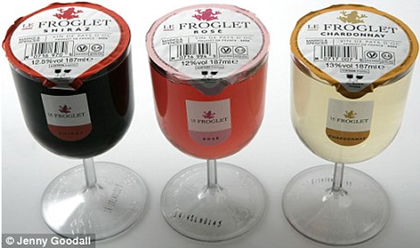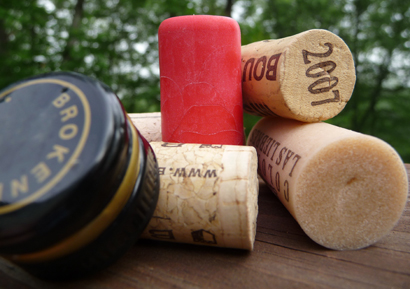Dr Vino's wine blog
wine talk that goes down easy
Tasting note generator given 99+ pt rating!
 Wine writers, already about as endangered as the Iberian lynx thanks to the sagging media world (not screwcaps), have something new to fear–automatically generated tasting notes! Have a taste of what the site spits out:
Wine writers, already about as endangered as the Iberian lynx thanks to the sagging media world (not screwcaps), have something new to fear–automatically generated tasting notes! Have a taste of what the site spits out:
Fully refined almost corpulent Chenin Blanc. Hits you with sage, boggling cardboard and bashful mint. Drink now through 2009.
Now, a sample of “extra silly:”
Neo-classic but equally longingly elegant Zinfandel. Forces smoked oyster, acidic monster gasoline and corpulent jack cheese. Drink now through eternity.
Greg Sumner, the site’s creator and soon-to-be wine overlord, pulls back the curtain to reveal the formula:
How it works.
It’s very simple. I put word types into arrays, then chose a word at random out of the array. The tasting note comes out in the following structure:(Intro) (Modifier) (Adjective) (Varietal).
(Adverb) (Adjective) (Flavor) flavors, (Adjective) (Flavor), and (Strength-word) (Flavor).
Drink (When) through (EndWhen).
Whoa, keep this thing away from sommelier robots! At least they don’t have a random score generator–yet.
Adventures in packaging: single-serve wine in a plastic glass!
Forget screwcaps versus corks: An English entrepreneur has sold this invention of single-serve plastic wine glasses–stem and all!–to Marks & Spencer, which now “struggles to keep up with demand.” He is laughing all the way to the bank since a business reality show in the UK called “Dragons’ Den” panned the idea when he presented it on the show. Sold under the brand “Le Froglet,” the individual 187ml glasses cost £2.25 ($3.33) for a Shiraz, Rose and Chardonnay, which, apparently, come from the Languedoc.
What say you: abomination or genius? Would this solve all your needs for wine in the back of a taxi? On a train home from work? At picnics? Your wine-through-a-straw needs?
“Wine-in-a-glass entrepreneur ridiculed in Dragons’ Den toasts M&S success” [Daily Mail; also image] Thanks, Jessica!
Which closure do you hate the most? [poll]
A few weeks ago, the Wall Street Journal ran a story about Nomacorc, a producer of synthetic corks. The story ran a graphic depicting market share by closure type, with data from Nomacorc. Corks were listed at 69%, plastic corks at 20%, and screw caps at 11%.
That struck me as not at all my experience: I would have guesstimated that screw caps outnumbered synthetic corks by two-to-one instead of the other way around. Finding data on closures is surprisingly difficult, especially data over time or by different world regions. In part, the difficulties lie in whether to limit the the wine market by bottle price or by size (e.g. are jug wines included).
A representative from the Cork Quality Council indicated that synthetic corks have an even larger market presence than Nomacorc’s estimates but underscored that a handful of purchasing directors control the lion’s share of synthetic closures.
Wine Business Monthly runs an annual report about closures. The 2009 report included responses from 229 wineries. Their data show a shift over five years toward “technical” corks (agglomerated granules of natural cork with natural cork disks glued to the ends) and away from synthetic corks (Nomacorc is extruded, making it a bit softer, whereas other plastic corks are injection molded, forming a more solid form; the red one in the photo above is injection molded. Read more about the differences here.). The report shows screw caps gaining market share.
While it is difficult to determine the precise relative market shares of each closure, we can express our opinions about closure type. The major downside of corks is the problem of cork taint (TCA), which can produce pungent aromas of moldy newspapers. Screw caps eliminate TCA but may create a virtually anaerobic environment that the wines become plagued by “reduction”–John Gilman expressed his dislike of screw caps here.
But plastic closures draw the most ire. Jancis Robinson has begged producers to stop using them, calling them “utterly infuriating.” David Schildknecht of the Wine Advocate has lamented in a review the loss of aromas over time in wines using this closure. Tom Matthews of Wine Spectator recently tweeted “2005 white Rhone + synthetic cork = 3 maderized bottles and several sad and angry wine lovers.”
What do you say–which closure type do you like the least? And feel free to add a comment with your thoughts on market share based on your experiences.
[poll id=”14″]
“Seeking Closure: Plastic Stoppers Crack 400-Year-Old Natural Cork” [WSJ]
When chenin blanc dazzles and sparkles: Huet, Laureau, Belliviere & more!
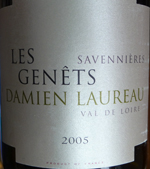 Chenin blanc is one of the world’s most underrated grapes. Beautifully multifaceted, it displays multiple forms: dry, off-dry, sweet and sparkling. It can tack on decades effortlessly. Here are a few more-or-less current releases that I have had recently (all on separate occasions) that are worth noting. (Search for these wines at retail.)
Chenin blanc is one of the world’s most underrated grapes. Beautifully multifaceted, it displays multiple forms: dry, off-dry, sweet and sparkling. It can tack on decades effortlessly. Here are a few more-or-less current releases that I have had recently (all on separate occasions) that are worth noting. (Search for these wines at retail.)
Domaine du Closel, La Jalousie, Savennieres, 2006. $18 I poured this wine with some apprehension at an event for 75 people recently. Would the gathered crowd “get” the wine? In fact, the color alone got them, as the golden wine appeared in their glasses. I polled them after tasting, and to my amazement, only two people disliked the wine–chenin blanc with such low negatives, it could run for office!
Domaine Laureau, Savennieres: Damien Laureau, aged 39, is not only the father of six children but also an up and coming star of the Savennieres appellation. Although he owns no vineyards in the appellation, he has long-term leases on two that he farms organically. I recently had the 2005 Les Genets bottling, which is aged for 18 months in vat. The wine is deliciously aromatic, layered, and complex on the palate and has the kind of lingering finish that tingles even your bones.
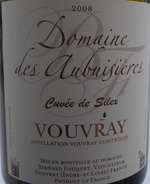 Domaine Aubuisieres, cuvée de silex, Vouvray, sec, 2008 $18: really a gorgeous example of chenin–and a good value too. Enticing aromas of honey and white flowers, delicious mouthfeel combining acidity and minerality in a wine with six grams of residual sugar, barely above the threshold of perception. Bernard Fouquet, somewhat controversially, bottles this wine under screw cap but my bottle was not showing any sign of reduction.
Domaine Aubuisieres, cuvée de silex, Vouvray, sec, 2008 $18: really a gorgeous example of chenin–and a good value too. Enticing aromas of honey and white flowers, delicious mouthfeel combining acidity and minerality in a wine with six grams of residual sugar, barely above the threshold of perception. Bernard Fouquet, somewhat controversially, bottles this wine under screw cap but my bottle was not showing any sign of reduction.
Francois Pinon, cuvée tradition, Vouuvray 2008. $17. Another great value Vouvray. I really liked the 2007s, so was a bit disappointed how closed and tightly minerally it was on day one. But on day two, the wine really opened up and was soaring. Although it’s not labeled as demi-sec, it is and has a superb texture. Also of note: Pinon’s sparkling Vouvray (now with a new label design) is a perennial excellent value at about $17.
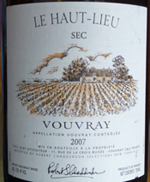 Domaine Huet, Le Mont, Vouvray, sec, 2007 $22.50: This legendary estate recently changed distributors and I picked up some bottles of this wine for an amazing price. The wine is really packed with minerality, acidity, medium weight, has an excellent arc and shows very well today since it has yet to hunker down for the long haul in the cellar. I’m doing a dinner for 200 next month and have put this wine on the menu, paired with halibut.
Domaine Huet, Le Mont, Vouvray, sec, 2007 $22.50: This legendary estate recently changed distributors and I picked up some bottles of this wine for an amazing price. The wine is really packed with minerality, acidity, medium weight, has an excellent arc and shows very well today since it has yet to hunker down for the long haul in the cellar. I’m doing a dinner for 200 next month and have put this wine on the menu, paired with halibut.
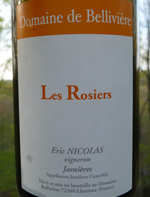 Domaine Belliviere, Jasnières, 2006. Along the northern fringe of the Loire, starting about ten years ago, Eric and Christine Nicolas have helped revive winemaking in the tiny appellation of Jasnières and surroundings. They have planted some new vineyards and also own some with over 50 years of age. (The two wines tasted here come from the younger vineyards.) The long, fluted bottles of Belliviere may make you think Riesling. But this is chenin through and through. The 2006 “Les Rosiers” (about $29) bottling is a serious wine and that possesses quite a layered structure mainly of the honey on rocks variety. Consider decanting. The 2006 “L’Effraie” bottling comes from the nearby Coteaux de Loir appellation and is slightly more accessible at this stage–I had it with a homemade spinach pizza and it worked well.
Domaine Belliviere, Jasnières, 2006. Along the northern fringe of the Loire, starting about ten years ago, Eric and Christine Nicolas have helped revive winemaking in the tiny appellation of Jasnières and surroundings. They have planted some new vineyards and also own some with over 50 years of age. (The two wines tasted here come from the younger vineyards.) The long, fluted bottles of Belliviere may make you think Riesling. But this is chenin through and through. The 2006 “Les Rosiers” (about $29) bottling is a serious wine and that possesses quite a layered structure mainly of the honey on rocks variety. Consider decanting. The 2006 “L’Effraie” bottling comes from the nearby Coteaux de Loir appellation and is slightly more accessible at this stage–I had it with a homemade spinach pizza and it worked well.
Better know a wine law: Maryland!
 Maryland, the home of the Fightin’ Terps, threatens to turn its wine lovers into perps: The laws governing these five and a half million residents make it a felony to order wine online and have it shipped to their homes. To purchase wines, consumers residing Annapolis, Baltimore or along the Chesapeake must buy from a local store; comparison shopping through retailers on the internet or ordering directly from a winery is illegal. (Small wonder neighboring DC is the thirstiest non-state in the nation.)
Maryland, the home of the Fightin’ Terps, threatens to turn its wine lovers into perps: The laws governing these five and a half million residents make it a felony to order wine online and have it shipped to their homes. To purchase wines, consumers residing Annapolis, Baltimore or along the Chesapeake must buy from a local store; comparison shopping through retailers on the internet or ordering directly from a winery is illegal. (Small wonder neighboring DC is the thirstiest non-state in the nation.)
Maryland is also home to 38 wineries today. Seeking to jump-start the domestic wine industry after Prohibition, the US Department of Agriculture turned to this mid-Atlantic state, opening an experimental winery in Beltsville, Maryland. Even though it was not long-lived, today’s wineries follow the early trail blazed by the Feds. The only problem: they cannot ship their wines to consumers in-state or out-of-state. In a recent survey (pdf), all but one winery respondents found this to negatively affect their business.
The keys to reforming the laws that have kept Marylanders locked out of the wine cellar for several decades may be within reach. Although the legislation has been introduced every year since 1981, Adam Borden, executive director of Marylanders for Better Beer and Wine Laws, says that this year it has majority support in both houses.
But the legislative path is not without roadblocks. Who has screwcaps big enough to stand in the path of this legislation? Senator Joan Carter Conway, chair of the Health and Education committee, threatened to stifle the bill in committee despite six of nine members being co-sponsors. But today, a committee in the House will hear testimony on the issue.
Robert Parker, Maryland’s best-known wine consumer, will not be testifying today since he is traveling, according to Borden.
Marylanders for Better Wine and Beer Laws and their page On Facebook
House Bill (80/141)
Senate Bill (26/47)
Advertising and ratings, binge drinking, screwcap suit – sipped and spit
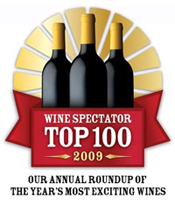 SIPPED: number crunching
SIPPED: number crunching
Wineries that advertise in Wine Spectator have their wines score better–but only by less than one point. Such is the finding in the lead article in the new issue of the Journal of Wine Economics. See the whole paper here as pdf or a blog reaction from the journal’s editor or a hard-hitting response from Robin Goldstein. The quantitative study looks only at reviews and does not examine the editorial, art, restaurant awards, or the Top 100 for advertiser bias. WS editor Tom Matthews responds to the research.
SPIT: binge drinking; SIPPED: wine tasting
An elite girls’ school in England has a new approach to tackling the problem of binge drinking: wine tastings. “We want to introduce the girls and their friends to good wines and their complexity, and educate them to develop an interest in the making of the wines rather than them seeing wine as something that you knock back in the summer holidays without thinking.” Revolutionary!! [The Indepdent; ht @candidwines]
SPIT: closures
Francis Ford Coppola’s winery produced a wine dubbed “encyclopedia” in a carafe-shaped bottle. The custom, oversized screwcaps leaked and ruined 55,000 cases of the wine, the winery alleges in a lawsuit filed against the screwcap’s manufacturer, Vinocor. [Bloomberg]
SPIT: pre-selling wine
Some California wineries are going all Rioja and consciously holding wines back for bottle aging–sometimes a decade or more–at the winery. [NYT]
SPIT: “me-too” wines
The New Zealand wine industry faces challenges, as bulk exports rise and prices fall. The NYT writes that the country’s vintners are “desperate to avoid the fate of neighboring Australia.”
Natural wines, premox, chenin blanc, 07 Port and Rhone – John Gilman
 John Gilman, author of the newsletter The View from the Cellar, joins us again for a Q&A. I asked him six questions; he replied with over 10,000 words! So grab a glass of wine, throw another log on the fire, grab a sandwich, channel your inner wine geek, and listen to John opine on the topics of natural wines, zero dosage champagne, some pitfalls of collecting, 2007 vintage for Port and in the Rhone, the nobility of chenin blanc, the Piedmont producer Produttori del Barbaresco and more!
John Gilman, author of the newsletter The View from the Cellar, joins us again for a Q&A. I asked him six questions; he replied with over 10,000 words! So grab a glass of wine, throw another log on the fire, grab a sandwich, channel your inner wine geek, and listen to John opine on the topics of natural wines, zero dosage champagne, some pitfalls of collecting, 2007 vintage for Port and in the Rhone, the nobility of chenin blanc, the Piedmont producer Produttori del Barbaresco and more!
Natural wines are growing in popularity. These include what might be termed “process controls” such as organic and biodynamic farming, favoring indigenous yeasts over commercial strains, as well as the rise of “no sulfur” wines. Are these wines forcibly better? Read more…
Vent your spleen: synthetic corks!
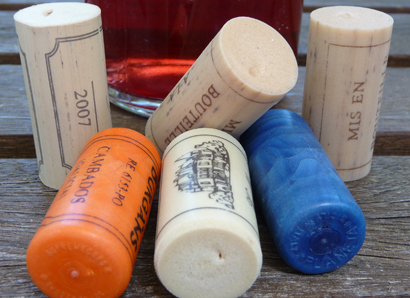
“Give me screwcaps or give me corks!” Patrick Henry presciently wrote in 1775. Er, maybe that was Jancis Robinson who wrote something like that in 2006.
But you get the idea. That middle ground between true cork and screwcap is occupied by the synthetic cork. On the plus side, there’s no TCA taint, which can arise with natural cork. But on the minus side, the little rubber bullets can be hard to get off the corkscrew (particularly the solid ones), nearly impossible to shove back in the bottle, not biodegradable, and until someone makes a wall of synthetic corks, they haven’t had much appeal being reused functionally or artistically.
What say you?
[poll id=”7″]
Related: “Vent your spleen: wax seals on wine bottles“
